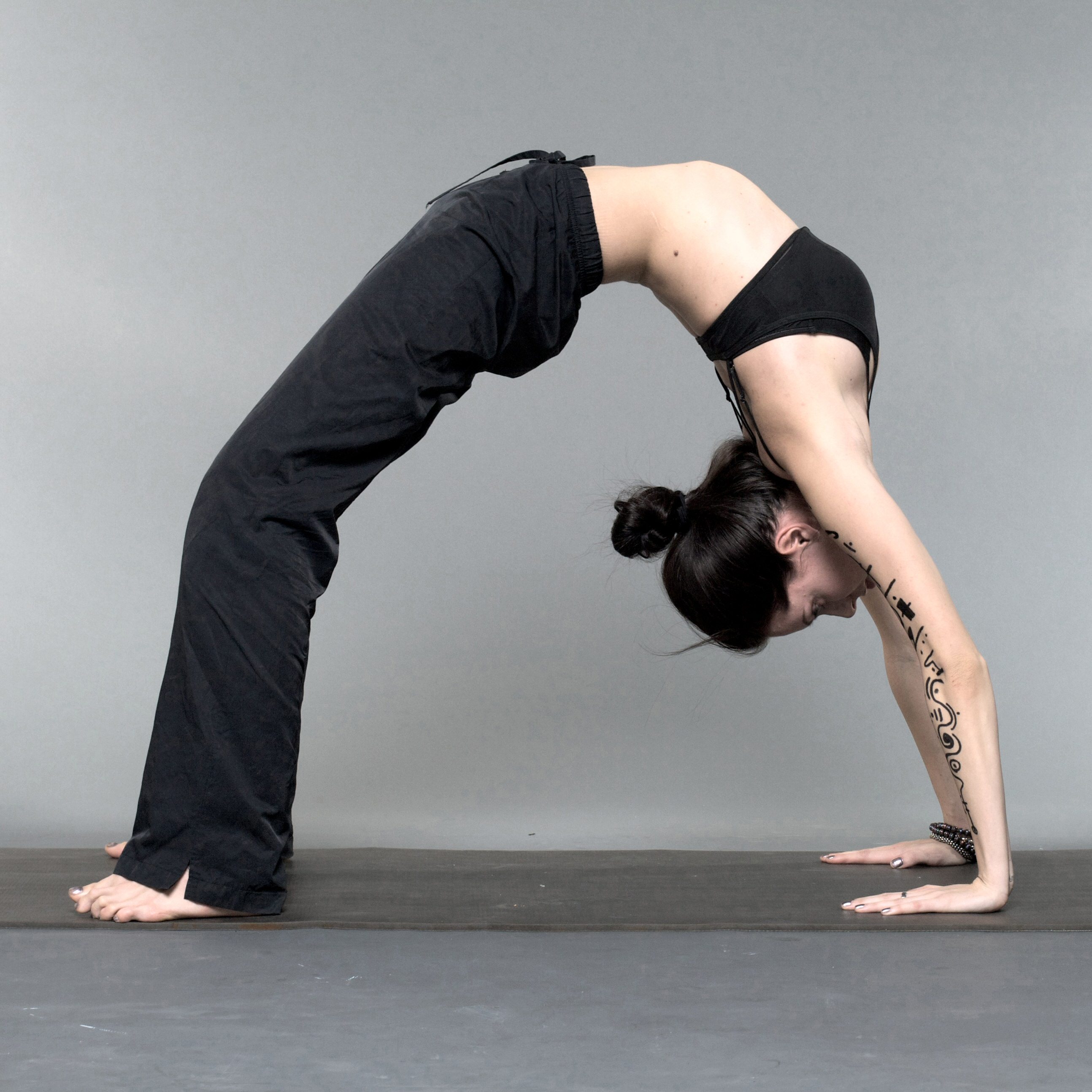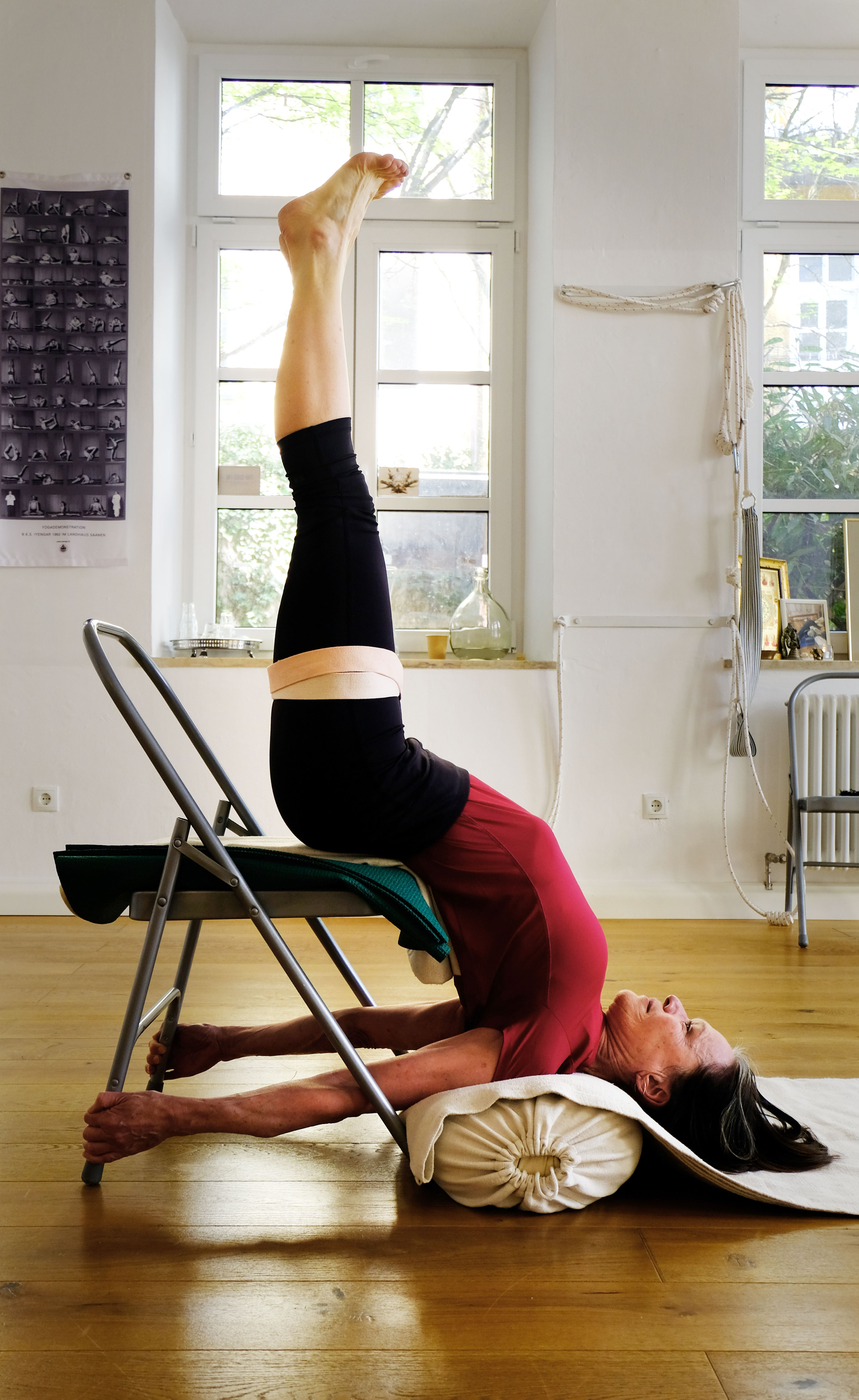|
Chakrasana
Chakrasana ( sa, चक्रासन, lit=Wheel Pose, translit=Cakrāsana) or Urdhva Dhanurasana ( sa, ऊर्ध्वधनुरासन, lit=Upward-Facing Bow Pose, translit=Ūrdhvadhanurāsana) is a backbending asana in yoga as exercise. The one-legged variant is often chosen by yoga practitioners who wish to advertise themselves. Etymology and origins The name Chakrasana comes from the Sanskrit words चक्र ''chakra'', "wheel", and आसन ''āsana'', "posture" or "seat". The name Urdhva Dhanurasana comes from the Sanskrit ''urdhva'' ऊर्ध्व, upwards, and ''dhanura'' धनु, a bow (for shooting arrows). The pose is illustrated in the 19th century ''Sritattvanidhi'' as ''Paryaṇkāsana'', Couch Pose. Description In the general form of the asana, the practitioner has hands and feet on the floor, and the abdomen arches up toward the sky. It may be entered from a supine position or through a less rigorous supine backbend, such as Setu Bandha Sar ... [...More Info...] [...Related Items...] OR: [Wikipedia] [Google] [Baidu] |
Asana
An asana is a body posture, originally and still a general term for a sitting meditation pose,Verse 46, chapter II, "Patanjali Yoga sutras" by Swami Prabhavananda, published by the Sri Ramakrishna Math p. 111 and later extended in hatha yoga and modern yoga as exercise, to any type of position, adding reclining, standing, inverted, twisting, and balancing poses. The '' Yoga Sutras of Patanjali'' define "asana" as " position thatis steady and comfortable". Patanjali mentions the ability to sit for extended periods as one of the eight limbs of his system.Patanjali '' Yoga sutras'', Book II:29, 46 Asanas are also called yoga poses or yoga postures in English. The 10th or 11th century ''Goraksha Sataka'' and the 15th century ''Hatha Yoga Pradipika'' identify 84 asanas; the 17th century ''Hatha Ratnavali'' provides a different list of 84 asanas, describing some of them. In the 20th century, Indian nationalism favoured physical culture in response to colonialism. In that envir ... [...More Info...] [...Related Items...] OR: [Wikipedia] [Google] [Baidu] |
Dhanurasana
Dhanurasana ( sa, धनुरासन, lit=Bow pose, translit=Dhanurāsana) is a back bending '' asana'' in ''hatha yoga'' and modern yoga as exercise. Etymology and origins The name comes from the Sanskrit words धनुर (dhanura) meaning " bow", and आसन (āsana) meaning "posture" or "seat". A similar pose named Nyubjasana, "the face-down asana", is described and illustrated in the 19th century ''Sritattvanidhi''. The pose is illustrated in half-tone in the 1905 ''Yogasopana Purvacatuska'' and named Dhanurāsana, quoting the ''Gheranda Samhitas description. It is unclear whether the asana is medieval, as although the name is used, the intended pose might be the sitting Akarna Dhanurasana rather than this backbend. The account of Dhanurasana in the 15th century ''Hatha Yoga Pradipika'' is ambiguous about whether the pose is reclining or sitting, stating The 17th century ''Gheranda Samhita'' is similarly ambiguous, stating Dhanurasana is used in the classical ... [...More Info...] [...Related Items...] OR: [Wikipedia] [Google] [Baidu] |
Setu Bandha Sarvangasana
Setu Bandha Sarvāṅgāsana (Sanskrit: सेतु बन्ध सर्वाङ्गासन), Shoulder supported bridge or simply Bridge, also called Setu Bandhāsana, is an inverted back-bending asana in hatha yoga and modern yoga as exercise. Etymology and origins The pose is named from the Sanskrit words सेतु ''Setu'', a bridge; बन्ध ''Bandha'', caught; सर्वा ''Sarva'', all; ङ्ग ''Anga'', limb; and आसन ''Asana'', seat or posture. The pose appears as "Kāmapīṭhāsana" in the 19th century ''Sritattvanidhi'' (written before 1868). Description The pose is entered from Sarvāṅgāsana (shoulderstand), the chest being held forwards by the hands and the feet lowered to the ground behind the back, the knees remaining bent; or more easily, by lifting the back from lying supine on the ground. The full pose has the knees bent and the ankles caught (''Bandha'') by the hands. The pose may be exited either by lying down or by jumping ba ... [...More Info...] [...Related Items...] OR: [Wikipedia] [Google] [Baidu] |
Utthita Vasisthasana
Utthita Vasisthasana (sometimes shortened to Vasisthasana) (Sanskrit: उत्थित वसिष्ठासन utthita vasiṣṭhāsana) or Side Plank pose is a balancing asana in modern yoga as exercise. Etymology and origins The name of the pose comes from the Sanskrit उत्थित ''Utthita'' extended, वसिष्ठ Vasiṣṭha, a sage, and आसन āsana, "posture" or "seat". The pose is not described in the medieval hatha yoga texts. It appears in the 20th century in the Ashtanga Vinyasa Yoga of Pattabhi Jois K. Pattabhi Jois (26 July 1915 – 18 May 2009) was an Indian yoga guru who developed and popularized the flowing style of yoga as exercise known as Ashtanga vinyasa yoga. In 1948, Jois established the Ashtanga Yoga Research Institute in Mys .... Description The pose is a balancing posture with the body, both legs, and both arms straight, the body on one side. The upper arm is raised as high as possible. The upper leg may be rested on ... [...More Info...] [...Related Items...] OR: [Wikipedia] [Google] [Baidu] |
Camatkarasana
Utthita Vasisthasana (sometimes shortened to Vasisthasana) (Sanskrit: उत्थित वसिष्ठासन utthita vasiṣṭhāsana) or Side Plank pose is a balancing asana in modern yoga as exercise. Etymology and origins The name of the pose comes from the Sanskrit उत्थित ''Utthita'' extended, वसिष्ठ Vasiṣṭha, a sage, and आसन āsana, "posture" or "seat". The pose is not described in the medieval hatha yoga texts. It appears in the 20th century in the Ashtanga Vinyasa Yoga of Pattabhi Jois. Description The pose is a balancing posture with the body, both legs, and both arms straight, the body on one side. The upper arm is raised as high as possible. The upper leg may be rested on the lower leg, or for the full pose (sometimes called Eka Pada Vasisthasana, One-legged Side Plank) may be raised as high as possible; the upper hand may grasp the foot (sometimes called Vasisthasana B), and the gaze may be directed to the upper hand. Var ... [...More Info...] [...Related Items...] OR: [Wikipedia] [Google] [Baidu] |
Supine Position
The supine position ( or ) means lying horizontally with the face and torso facing up, as opposed to the prone position, which is face down. When used in surgical procedures, it grants access to the peritoneal, thoracic and pericardial regions; as well as the head, neck and extremities. Using anatomical terms of location, the dorsal side is down, and the ventral side is up, when supine. Semi-supine In scientific literature "semi-supine" commonly refers to positions where the upper body is tilted (at 45° or variations) and not completely horizontal. Relation to sudden infant death syndrome The decline in death due to sudden infant death syndrome (SIDS) is said to be attributable to having babies sleep in the supine position. The realization that infants sleeping face down, or in a prone position, had an increased mortality rate re-emerged into medical awareness at the end of the 1980s when two researchers, Susan Beal in Australia and Gus De Jonge in the Netherlands, in ... [...More Info...] [...Related Items...] OR: [Wikipedia] [Google] [Baidu] |
Yoga Using Props
Props used in yoga include chairs, Yoga brick, blocks, belts, Yoga mat, mats, blankets, bolsters, and straps. They are used in Yoga as exercise, postural yoga to assist with correct alignment in an asana, for ease in mindful yoga practice, to enable poses to be held for longer periods in Yin Yoga, where support may allow muscles to relax, and to enable people with movement restricted for any reason, such as stiffness, injury, or arthritis, to continue with their practice. One prop, the yoga strap, has an ancient history, being depicted in temple sculptures and described in manuscripts from ancient and medieval times; it was used in ''Sopasrayasana'', also called ''Yogapattasana'', a seated Meditation posture, meditation pose with the legs crossed and supported by the strap. In modern times, the use of props is associated especially with the yoga guru B. K. S. Iyengar; his disciplined style required props including belts, blocks, and ropes. History The ''yogapaṭṭa'' in scu ... [...More Info...] [...Related Items...] OR: [Wikipedia] [Google] [Baidu] |
Hashtag
A hashtag is a metadata tag that is prefaced by the hash (also known as pound or octothorpe) sign, ''#''. On social media, hashtags are used on microblogging and photo-sharing services such as Twitter or Instagram as a form of user-generated tagging that enables cross-referencing of content by topic or theme. For example, a search within Instagram for the hashtag ''#bluesky'' returns all posts that have been tagged with that term. After the initial hash symbol, a hashtag may include letters, numerals, or underscores. The use of hashtags was first proposed by American blogger and product consultant Chris Messina in a 2007 tweet. Messina made no attempt to patent the use because he felt that "they were born of the internet, and owned by no one". Hashtags became entrenched in the culture of Twitter and soon emerged across Instagram, Facebook, and YouTube. In June 2014, ''hashtag'' was added to the ''Oxford English Dictionary'' as "a word or phrase with the symbol ''#'' in fro ... [...More Info...] [...Related Items...] OR: [Wikipedia] [Google] [Baidu] |
Spandex
Spandex, Lycra, or elastane is a synthetic fiber known for its exceptional elasticity. It is a polyether- polyurea copolymer that was invented in 1958 by chemist Joseph Shivers at DuPont's Benger Laboratory in Waynesboro, Virginia, US. The generic name "spandex", which is an anagram of the word "expands", is the preferred name in North America. In continental Europe, it is referred to by variants of "elastane", including (France), (Germany, Sweden), (Spain), (Italy), and (Netherlands); and in the UK, Ireland, Portugal, Spain, Latin America, Australia, and New Zealand, it is primarily known as "Lycra". Brand names for spandex include Lycra (made by The Lycra Company, previously a division of DuPont Textiles and Interiors), Elaspan (The Lycra Company), Acepora ( Taekwang Group), Creora ( Hyosung), INVIYA ( Indorama Corporation), ROICA and Dorlastan ( Asahi Kasei), Linel (Fillattice), and ESPA ( Toyobo). History In the post-World War II era, DuPont Textiles Fib ... [...More Info...] [...Related Items...] OR: [Wikipedia] [Google] [Baidu] |
Instagram
Instagram is a photo and video sharing social networking service owned by American company Meta Platforms. The app allows users to upload media that can be edited with filters and organized by hashtags and geographical tagging. Posts can be shared publicly or with preapproved followers. Users can browse other users' content by tag and location, view trending content, like photos, and follow other users to add their content to a personal feed. Instagram was originally distinguished by allowing content to be framed only in a square (1:1) aspect ratio of 640 pixels to match the display width of the iPhone at the time. In 2015, this restriction was eased with an increase to 1080 pixels. It also added messaging features, the ability to include multiple images or videos in a single post, and a Stories feature—similar to its main competitor Snapchat—which allowed users to post their content to a sequential feed, with each post accessible to others for 24 hours. As of Jan ... [...More Info...] [...Related Items...] OR: [Wikipedia] [Google] [Baidu] |
The Independent
''The Independent'' is a British online newspaper. It was established in 1986 as a national morning printed paper. Nicknamed the ''Indy'', it began as a broadsheet and changed to tabloid format in 2003. The last printed edition was published on Saturday 26 March 2016, leaving only the online edition. The newspaper was controlled by Tony O'Reilly's Irish Independent News & Media from 1997 until it was sold to the Russian oligarch and former KGB Officer Alexander Lebedev in 2010. In 2017, Sultan Muhammad Abuljadayel bought a 30% stake in it. The daily edition was named National Newspaper of the Year at the 2004 British Press Awards. The website and mobile app had a combined monthly reach of 19,826,000 in 2021. History 1986 to 1990 Launched in 1986, the first issue of ''The Independent'' was published on 7 October in broadsheet format.Dennis Griffiths (ed.) ''The Encyclopedia of the British Press, 1422–1992'', London & Basingstoke: Macmillan, 1992, p. 330 It was prod ... [...More Info...] [...Related Items...] OR: [Wikipedia] [Google] [Baidu] |





.jpg)
